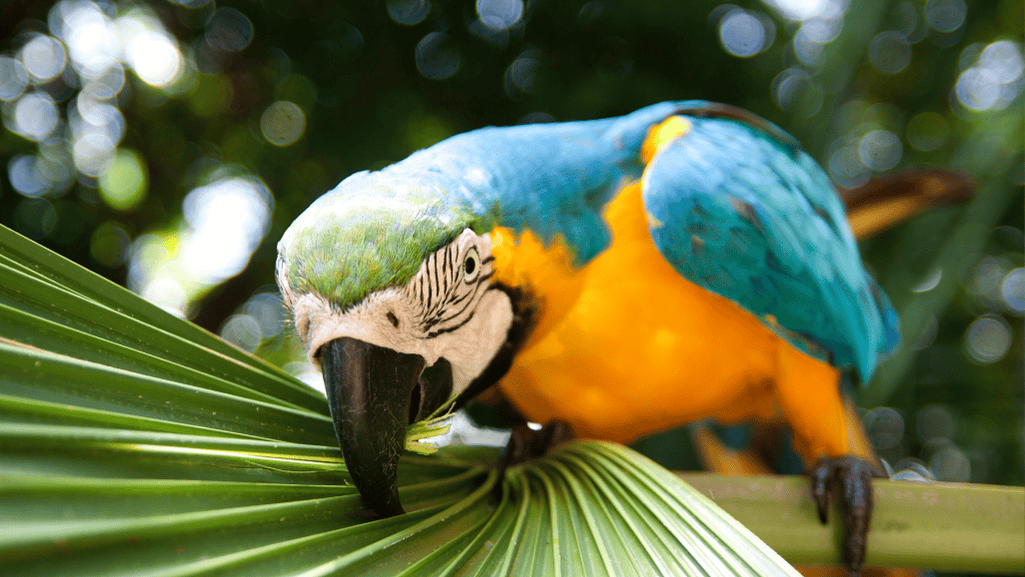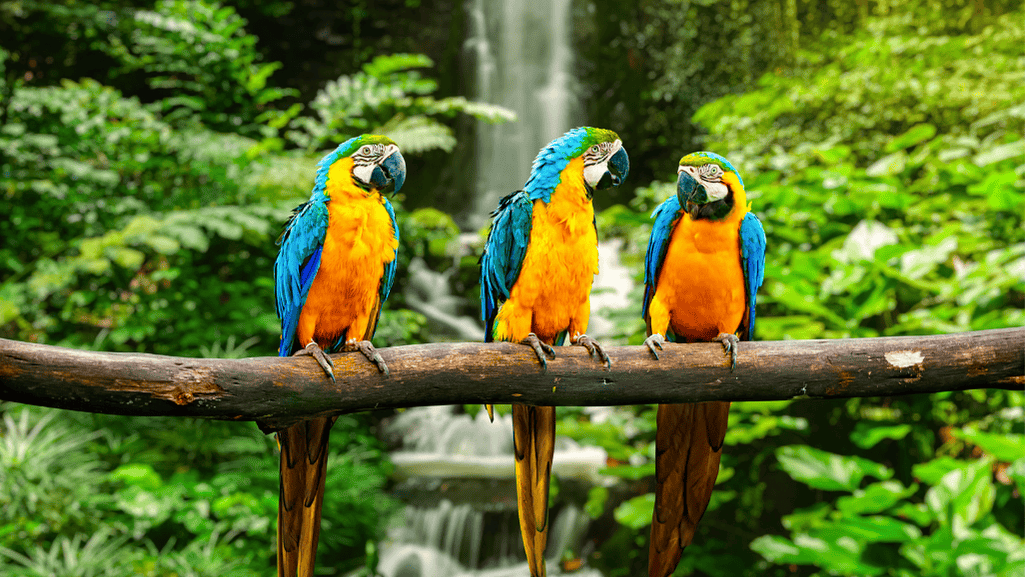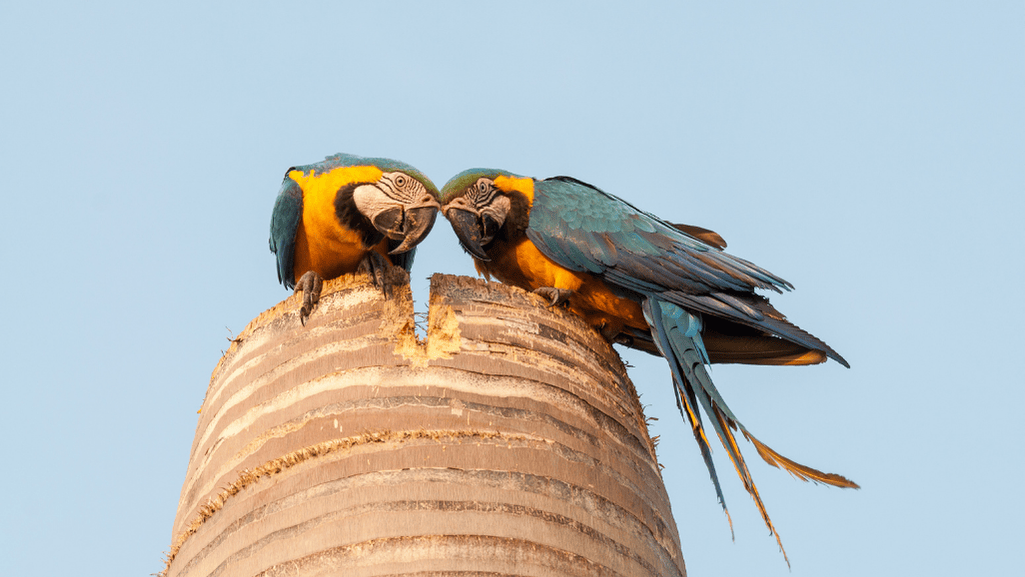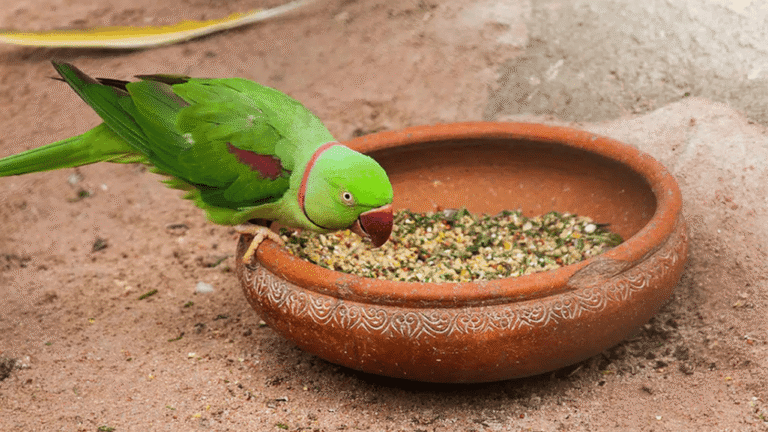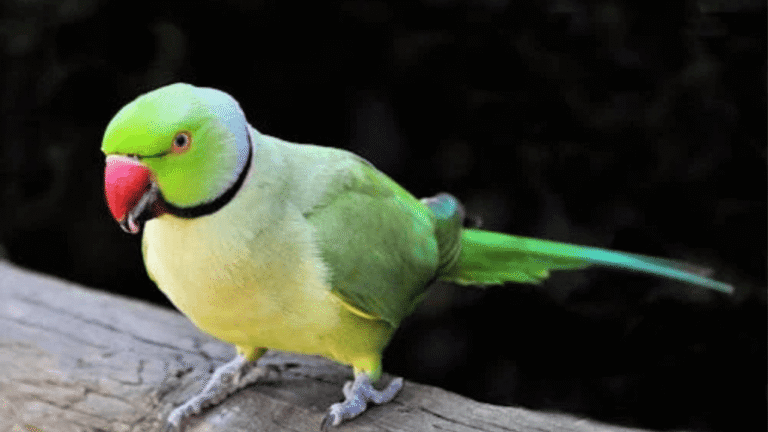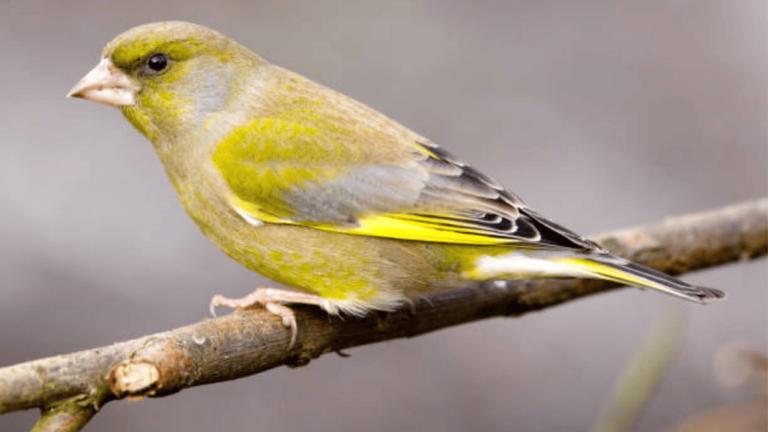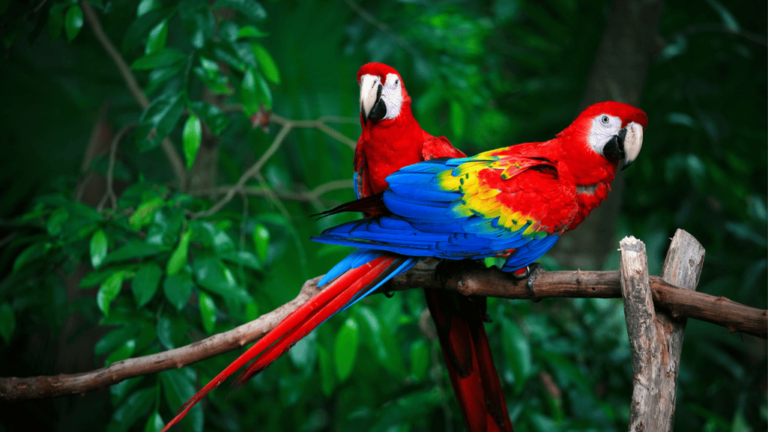Get ready to be amazed by the stunning beauty of the blue and yellow macaw, also known as the ara ararauna. Their vibrant feathers are sure to grab your attention. These birds are popular pets and live in the rainforests of South America.
These birds are truly remarkable. They have striking colors and are very intelligent. They live in the forests of South America, from Panama to Argentina. Their beauty has won the hearts of bird lovers all over the world.
As we explore the blue and yellow macaw, we’ll learn about their looks, behavior, diet, and how they’re doing. By understanding these birds, we can appreciate their role in nature. We also need to protect them for future generations.
Key Takeaways
- Blue and yellow macaws are among the largest parrots in the world, with a length of around 85cm and a wingspan of up to 100cm.
- These colorful birds are native to the forests of South America, from Panama to Argentina.
- Blue and yellow macaws are known for their intelligence, sociability, and impressive vocalization skills.
- They are popular exotic pets but face threats such as habitat loss, hunting, and the illegal pet trade in the wild.
- Understanding and protecting blue and yellow macaws is crucial for preserving the beauty and diversity of the natural world.
Introduction to the Blue and Yellow Macaw
The blue and yellow macaw, also known as the blue-and-gold macaw, is a stunning avian species. It captures the hearts of bird enthusiasts and nature lovers. These magnificent birds are native to the tropical regions of South America.
Belonging to the parrot family, the blue and yellow macaw is a marvel. These large parrots can reach lengths of 76–86 cm and weigh between 0.9–1.5 kg. They are among the largest parrot species in existence.
The blue-and-yellow macaw is one of the largest parrots in the world, with an average length of around 85cm and a wingspan of up to 100cm.
Their striking appearance features vibrant plumage. They have a brilliant blue back and wings, with a golden-yellow chest and underside. Their expressive faces have a black beak and a patch of bare white skin around their eyes.
These intelligent and social birds form strong bonds. They engage in playful interactions and vocalizations. In the wild, they can live up to 35 years. Captive individuals with proper care can live over 60 years.
| Characteristic | Details |
|---|---|
| Length | 76–86 cm |
| Weight | 0.9–1.5 kg |
| Lifespan (Wild) | 30–35 years |
| Lifespan (Captive) | Up to 60 years or more |
| Sexual Maturity | 3–6 years |
Unfortunately, the blue and yellow macaw faces threats. Habitat loss, fragmentation, and the illegal pet trade are major concerns. Avian conservation efforts are crucial for their survival.
As we explore the blue and yellow macaw’s world, let’s appreciate their beauty and intelligence. Understanding their unique characteristics and conservation needs helps us preserve these incredible South American parrots for future generations.
Physical Characteristics and Appearance
The Blue and Yellow Macaw, also known as the Blue and Gold Macaw, is a stunning large parrot species. It captivates with its vibrant plumage and striking appearance. These majestic birds are among the largest macaws, measuring approximately 85 to 90 cm (34 to 36 in.) in length and boasting an impressive wingspan of 102 to 112.5 cm (41 to 45 in.).
Vibrant Plumage and Coloration
The Blue and Yellow Macaw’s feathers are breathtaking. The upper body is rich, deep blue, while the lower body is brilliant golden yellow. The bird’s head features a green patch, adding contrast to its exotic appearance.
The bright blue feathers on the wings and tail create a striking contrast against the yellow feathers on the head, chest, and belly. These colorful feathers not only make the Blue and Yellow Macaw a sight to behold but also help camouflage them in their natural habitat.
Size and Weight
As one of the larger macaw species, the Blue and Yellow Macaw is an impressive bird. Adult macaws typically weigh between 900 to 1200 g (2 to 2.7 lbs.), making them substantial feathered companions. Their considerable size is further emphasized by their long, tapered tails, which can account for up to half of their total body length.
| Measurement | Value |
|---|---|
| Length | 85 to 90 cm (34 to 36 in.) |
| Wingspan | 102 to 112.5 cm (41 to 45 in.) |
| Weight | 900 to 1200 g (2 to 2.7 lbs.) |
Beak and Feet Adaptations
The Blue and Yellow Macaw’s beak and feet are perfectly adapted to its lifestyle. The strong, curved black beak is ideal for cracking open tough nuts and seeds. This allows the bird to access nutrient-rich food sources.
The macaw’s feet are equally impressive, with their dexterous toes and powerful grip. These adaptations enable the bird to grasp and manipulate objects with ease. This showcases their remarkable avian intelligence.
The Blue and Yellow Macaw’s physical characteristics are a testament to the incredible diversity and beauty found in the natural world. From their vibrant plumage to their specialized adaptations, these birds are truly awe-inspiring creatures.
Natural Habitat and Distribution
The blue and yellow macaw is a stunning bird of the Amazon rainforest. It lives in the lush forests of Central and South America. These birds add to the beauty and diversity of the Amazon basin.
These birds can be found in many countries. Their range goes from eastern Panama to northern Argentina. They love the humid forests, swamp forests, and palm swamps.
Tropical and Subtropical Forests
The blue and yellow macaw loves the Amazon rainforest. It’s perfect for these birds, with tall trees and lots of food. The rainforest’s weather is just right for them.
Range from Central to South America
These birds are found in many countries. In 2018, they were seen in Bolivia, Brazil, and more. They even live in Puerto Rico, where they were introduced.
| Country | Presence in 2018 |
|---|---|
| Bolivia | Yes |
| Brazil | Yes |
| Colombia | Yes |
| Ecuador | Yes |
| French Guiana | Yes |
| Guyana | Yes |
| Panama | Yes |
| Paraguay | Yes |
| Peru | Yes |
| Puerto Rico | Introduced |
| Suriname | Introduced |
| Trinidad & Tobago | Extinct (1970s), Reintroduced (2000s) |
| Venezuela | Yes |
While these birds are common in many places, some are rare. This is due to the pet trade and habitat loss. We need to protect them to keep the rainforest rich and diverse.
Behavior and Social Structure
The blue and yellow macaw is a highly intelligent bird known for its remarkable avian intelligence and fascinating bird behavior. These magnificent creatures are not only visually stunning but also possess a range of social and cognitive abilities that captivate bird enthusiasts and researchers alike.
Highly Social and Intelligent Birds
Blue and yellow macaws are incredibly social birds, thriving in the company of their own kind. They form strong bonds with their mates and family members, often engaging in mutual preening and sharing food. These interactions showcase their advanced social skills and the importance of companionship in their lives.
In addition to their social nature, blue and yellow macaws exhibit remarkable avian intelligence. They are curious and exploratory, constantly interacting with their environment and learning from their experiences. These intelligent birds have been observed using tools, solving complex problems, and even engaging in playful behavior, demonstrating their cognitive abilities.
Strong Bonds with Mates and Family
Blue and yellow macaws form monogamous pairs that mate for life, showcasing the depth of their emotional connections. These strong bonds are evident in their daily interactions, as they fly together, forage for food, and support each other through various challenges.
Family ties are also crucial for these birds. Parents invest significant time and energy in raising their chicks, providing them with the necessary care, protection, and guidance. This dedication ensures the survival and well-being of the next generation, highlighting the importance of strong family bonds in the world of blue and yellow macaws.
Vocalization and Mimicry Skills
One of the most fascinating aspects of blue and yellow macaw behavior is their remarkable vocalization and mimicry skills. These birds are known for their loud, distinctive calls that can be heard from miles away in their natural habitats. Their vocalizations serve various purposes, including communication, alerting others to potential threats, and maintaining social bonds.
Blue and yellow macaws are also excellent mimics, capable of imitating a wide range of sounds, from human speech to other bird calls. This ability has made them popular as pet birds, as they can learn to mimic words and phrases with impressive accuracy. However, it is crucial to remember that proper avian care and parrot training are essential to ensure their well-being in captivity.
| Behavior | Description |
|---|---|
| Social Structure | Form strong bonds with mates and family, often traveling in pairs or gathering in large flocks |
| Intelligence | Exhibit advanced cognitive abilities, use tools, solve problems, and engage in playful behavior |
| Vocalization | Produce loud, distinctive calls for communication, alerting others, and maintaining social bonds |
| Mimicry | Excellent mimics, capable of imitating human speech and other bird calls with impressive accuracy |
Understanding the behavior and social structure of blue and yellow macaws is crucial for their conservation and the promotion of responsible pet bird care. By appreciating their intelligence, social needs, and unique abilities, we can work towards creating a world where these magnificent birds thrive both in the wild and in the hearts of bird enthusiasts everywhere.
Diet and Feeding Habits
The Blue and Yellow Macaw is a stunning exotic pet with vibrant colors. It needs a balanced diet to stay healthy in captivity. Knowing what to feed them is key to their well-being.
In the wild, these birds eat seeds, nuts, fruits, and plants. Their diet is full of nutrients that keep them healthy. As pets, we should try to give them a similar diet to avoid health problems.
A good diet for a Blue and Yellow Macaw includes high-quality pellets. These should make up 75-80% of their food. Brands like Harrison’s, Roudybush, and Zupreem offer great options for avian care.
Along with pellets, they should eat fresh fruits and veggies. These should make up 20-25% of their diet. Some good options include:
- Fruits: Apples, pears, grapes, berries, melon, papaya, mango
- Vegetables: Carrots, sweet potatoes, bell peppers, broccoli, spinach, kale
Don’t give them avocado, chocolate, or rhubarb because they’re toxic. Nuts like walnuts, almonds, and Brazil nuts can be treats but in small amounts because of their fat.
“The key to a healthy Blue and Yellow Macaw is a balanced diet that closely mimics their natural feeding habits in the wild.” – Dr. Julia Barroso, Avian Veterinarian
Always have fresh, clean water for your macaw to drink and bathe in. It’s important for their health and plumage. Watching their food intake and providing fresh water daily is crucial for their care.
| Food Type | Percentage of Diet | Examples |
|---|---|---|
| Pellets | 75-80% | Harrison’s, Roudybush, Zupreem |
| Fruits and Vegetables | 20-25% | Apples, carrots, bell peppers, spinach |
| Nuts and Seeds | Occasional treats | Walnuts, almonds, Brazil nuts |
By giving them a balanced diet, you can help your Blue and Yellow Macaw stay healthy and happy. Proper nutrition is key to their well-being and a long, happy life with your family. It’s the foundation of bird care and unlocks their full potential as exotic animals.
Reproduction and Nesting
The life cycle of Blue and Yellow Macaws is fascinating. They form lifelong pairs, showing their deep commitment. Avian breeding programs help us understand their behavior and keep their species alive.
Mating and Pair Bonding
Blue and Yellow Macaws have strong pair bonds. They go through complex courtship rituals, like vocalizing and preening together. This shows their deep emotional connections and the value of social bonds.
Nesting Sites and Egg Laying
These birds nest in tree cavities or rocky cliffs. They line their nests with soft materials for their eggs. Females lay 2 to 4 eggs, with an average of 2.6 per clutch. Both parents incubate the eggs, keeping them warm and safe.
Conservation efforts focus on providing good nesting sites. Studies show that managing Mauritia flexuosa palms can encourage nesting. This approach helps create thriving colonies for these birds.
Parental Care and Chick Development
After hatching, both parents care for the chicks. They feed them regurgitated food, rich in nutrients. As the chicks grow, they start eating solid foods, getting a balanced diet.
Proper care is key for the chicks’ growth. Avian breeding programs have developed special diets and housing. This ensures the chicks grow well and can fly successfully, contributing to their species’ future.
The reproduction and nesting of Blue and Yellow Macaws show nature’s power and these birds’ resilience. Thanks to conservation and dedicated work, future generations will be amazed by these birds’ beauty and grace.
Conservation Status and Threats
The blue-and-yellow macaw faces big challenges in the wild. Even though it’s found in many parts of tropical South America, it’s at risk. The International Union for Conservation of Nature (IUCN) says it’s “Least Concern,” but we must act fast to protect these birds.
Current Population Trends
There are over 10,000 blue-and-yellow macaws worldwide. But, some places like Paraguay are seeing their numbers drop fast. We need to act quickly to save these birds and their homes.
Habitat Loss and Fragmentation
Habitat loss is a big problem for blue-and-yellow macaws. Tropical forests are being cut down for farming, logging, and cities. We must protect and restore their homes to save these birds and many others.
| Country | Population Status |
|---|---|
| Brazil | Endangered |
| Bolivia | Endangered |
| Uruguay | Endangered |
| Trinidad | Endangered |
Illegal Pet Trade and Poaching
The illegal pet trade is a big threat to blue-and-yellow macaws. People want them as pets, leading to many being caught and sold. We must stop poachers and reduce the demand for these birds.
Over 50 threatened species have been identified as potentially benefiting from captive breed and release programs, offering hope for the future of endangered birds like the blue-and-yellow macaw.
There’s hope for saving the blue-and-yellow macaw. Groups and people are working hard to protect them. By supporting these efforts, we can help these birds thrive for future generations.
The Blue and Yellow Macaw as Pets
For those seeking a vibrant and engaging avian pet, the Blue and Yellow Macaw is a great choice. Known as the Blue and Gold Macaw, these birds are popular pets. They have striking colors and charming personalities.
Personality and Temperament
Blue and Yellow Macaws are known for being friendly and smart. They love to learn and talk, making them great companions. They get along well with people and other birds, showing their friendly side.
These birds need lots of attention and mental stimulation. They can be demanding if they don’t get enough. But with the right care, they can bring joy and companionship for many years.
Housing and Dietary Requirements
Blue and Yellow Macaws need big cages to be happy. Their cages should be at least 5 feet tall and 3 to 4 feet wide. This gives them room to move and play.
They eat a mix of pellets, nuts, seeds, fruits, and veggies. A balanced diet is key to their health. It’s important to talk to a vet to make sure they’re eating right.
| Characteristic | Details |
|---|---|
| Length | 30-33 inches |
| Weight | 850-1300 grams |
| Life Span | Up to 50 years |
| Age at Maturity | 3-6 years old |
| Breeding Age | Approximately 30-35 years old |
| Breeding Season | Usually spring and early summer |
| Clutch Size | 2-4 eggs |
| Incubation Period | Average 25.5 days |
| Minimum Cage Size | 5′ x 5′ x 8′ |
Training and Enrichment
Blue and Yellow Macaws are great at learning tricks and even excel in bird shows. They are smart and eager to please. Owners often take them out in public, showing off their skills.
These birds are excellent talkers and can learn many words. With training, they can say up to 20 words clearly. Books like “The Parrot Problem Solver” and “Clicker Training for Birds” can help with training.
The book “The Large Macaws: Their Care, Breeding, and Conservation” is considered one of the best resources about macaws, providing comprehensive information on their care, behavior, and conservation.
Keeping Blue and Yellow Macaws happy means giving them lots of playtime and mental challenges. They need at least 2 to 3 hours of playtime outside their cage each day. Toys, perches, and puzzles keep them busy and prevent boredom.
While they make amazing pets, owning a Blue and Yellow Macaw is a big responsibility. They live a long time, need lots of attention, and have strong beaks. They are best for experienced bird lovers who can provide the care and resources they need.
Interesting Facts about the Blue and Yellow Macaw
The Blue and Yellow Macaw is a stunning tropical bird. It has vibrant plumage, showing off bright blue and golden yellow feathers. Birdwatching enthusiasts and nature lovers are captivated by its beauty and intelligence.
These birds are impressive in size. They have a body length of nearly 3 feet and a wingspan of up to 4 feet. Despite their size, they are agile flyers, performing breathtaking aerial acrobatics.
In their native habitats, Blue and Yellow Macaws form large flocks, often with 100 individuals. They are social birds that mate for life, showing strong bonds with their partners. Their intelligence is evident in their ability to mimic human speech, making them popular companions.
“The Blue and Yellow Macaw is a symbol of the richness and diversity of the Brazilian fauna, captivating the hearts of nature lovers worldwide with its striking beauty and remarkable intelligence.”
Did you know the Blue and Yellow Macaw is a monotypic species? There is only one recognized subspecies. However, some experts suggest there are two variations: the Bolivian Blue and Gold Macaw and the Blue-throated Macaw.
| Characteristic | Blue and Yellow Macaw |
|---|---|
| Body Length | Nearly 3 feet |
| Wingspan | Up to 4 feet |
| Weight | Up to 3 pounds |
| Lifespan | Up to 80 years |
| Native Range | South America (Brazil, Venezuela, Peru, Bolivia, Paraguay) |
Another interesting fact is that the Blue and Yellow Macaw is a monomorphic species. Males and females look similar, with no distinct differences. The only way to determine their sex is through surgical or genetic testing.
The Blue and Yellow Macaw’s conservation status is listed as “Least Concern.” This means their population is stable and healthy. It’s important to protect their habitats and raise awareness about preserving these magnificent birds for future generations.
The Importance of Preserving Blue and Yellow Macaw Populations
Keeping blue and yellow macaws safe is key to the health of rainforests. These birds help spread seeds, which helps the forest grow and stay diverse. By protecting their homes, we help these birds and many others that live there too.
Ecological Significance
Blue and yellow macaws are vital in the Amazon rainforest. They help plants grow by eating and spreading seeds. The palm swamps are crucial for their survival, as they nest and find food there. Saving these areas helps macaws thrive and keeps the forest balanced.
Macaws also show us how healthy the forest is. Their numbers tell us about the ecosystem’s health. This helps us know where to focus our conservation efforts.
Cultural and Economic Value
Macaws are important for more than just the environment. They have deep cultural and economic value. For years, local communities have used their feathers in art and traditions. Saving macaws helps protect these traditions and supports local businesses through eco-tourism.
These birds are loved around the world, not just in their natural habitats. As pets, they need special care. Taking care of them responsibly helps ensure their wild friends are not harmed.
To save blue and yellow macaws, we need to tackle big threats like losing their homes and being taken as pets. We can do this by creating protected areas, working with communities, and enforcing laws. This will help these birds and their homes thrive.
Only 30 years ago, the Blue-throated Macaw was feared extinct, with an estimated population of as few as 100 individuals. Thanks to the dedicated efforts of organizations like Asociación Armonía, over 6,000 macaws have been saved, and the population at the Barba Azul Nature Reserve has steadily increased, reaching a record of 228 birds roosting at a single forest island.
Stories of saving endangered species give us hope. They show us that with hard work and dedication, we can protect these amazing birds and their homes.
Conclusion
The blue and yellow macaw, also known as the ara ararauna, is a captivating and intelligent bird. It has won the hearts of many. These macaws are popular pets because of their stunning colors, size, and engaging personalities.
But, it’s important to remember that these birds are more than just pets. They are a key part of their ecosystems.
Even though they are not currently considered endangered, blue and yellow macaws still face threats. These include habitat loss, fragmentation, and the illegal pet trade. To protect them, we must support efforts to save their habitats and reduce the demand for wild-caught birds.
By preserving their forests and promoting responsible pet ownership, we can help. This way, we can keep the ecosystems they support healthy.
In conclusion, the blue and yellow macaw reminds us of nature’s incredible diversity and beauty. As we admire their intelligence, social bonds, and colors, we must also remember our duty to protect them.
By working together to safeguard their future, we ensure their survival. This not only helps this iconic species but also benefits our planet.


